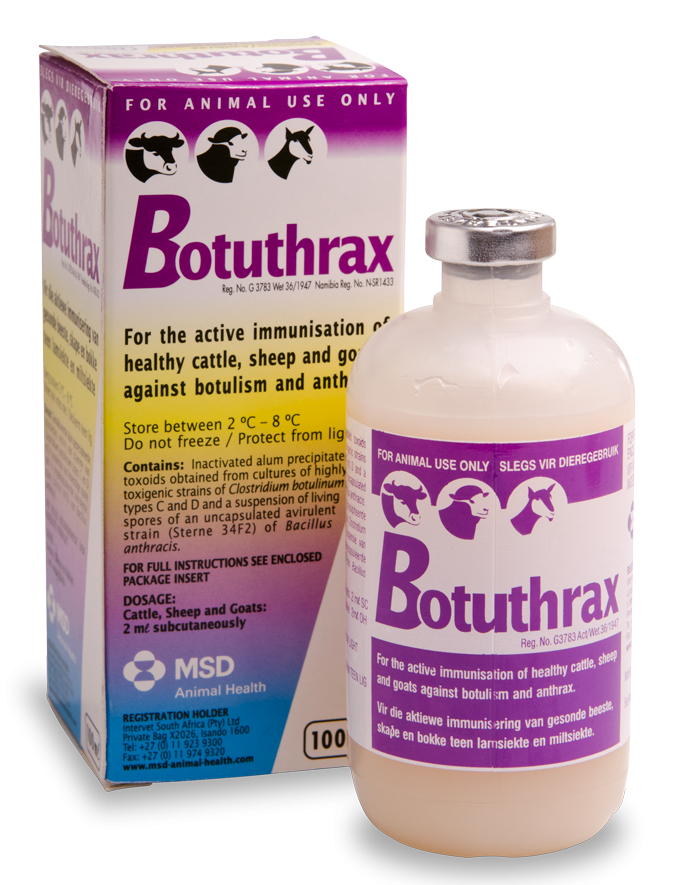Botuthrax®
For the active immunisation of healthy cattle, sheep and goats against botulism and anthrax.

FOR ANIMAL USE ONLY
BOTUTHRAX®
Reg. No. G3783 (Act 36/1947)
Namibia Reg. No V07/24.4/54 [NS0]
Anthrax is a controlled disease in terms of the animal diseases act (Act 35/1984). The occurrence or suspicion of the disease must be reported to the responsible state veterinarian immediately.
INDICATIONS
For the active immunisation of healthy cattle, sheep and goats against botulism and anthrax. Immunity is established within 3 to 4 weeks after inoculation and lasts for approximately 1 year.
COMPOSITION
Botuthrax® contains inactivated alum-precipitated toxoids obtained from cultures of highly toxigenic strains of Clostridium botulinum types C and D and a suspension of live spores of an uncapsulated avirulent strain (Sterne 34F2) of Bacillus anthracis.
STORAGE INSTRUCTIONS
- Store between 2 °C – 8 °C in a refrigerator.
- Do not freeze.
- Protect from light.
WARNINGS
- Withdrawal period: Do not slaughter animals for human consumption within 21 days of vaccination.
- Vaccination of stressed animals should be avoided.
- Usually, no marked reaction follows vaccination although a transient swelling may appear at the site of inoculation, and some animals may show a moderate rise in temperature for 1 or 2 days.
- Vaccination is not a substitute for supplementary feeding of phosphorous when grazing is deficient in this element.
- As with all vaccines, occasional hypersensitivity reactions may occur. In such cases, appropriate treatment should be administered without delay.
- Concurrent administration of antibiotics to vaccinated animals is contraindicated as the antibiotic will interfere with the vaccine. Antibiotics should not be given for several days before and at least 15 days after vaccination.
- As usual, with all vaccines, absolute immunity cannot be guaranteed in all animals. Therefore, it is advisable to contact a veterinarian regarding additional control measures, instead of relying on the vaccine alone.
- KEEP OUT OF REACH OF CHILDREN, UNINFORMED PERSONS AND ANIMALS.
- Although this vaccine has been extensively tested under a large variety of conditions, failure thereof may ensue as a result of a wide range of reasons. If this is suspected, seek veterinary advice and notify the registration holder.
PRECAUTIONS
- Observe aseptic precautions. Ensure that vaccination equipment (needles, syringes, etc.) is clean and sterile prior to and during use.
- Do not use alcohol or other disinfectants to clean needles.
- Partially used containers should be disposed of at the end of each day’s operation since under field conditions, it may be difficult to avoid accidental contamination of the vaccine.
- Destroy any unused vaccine and dispose of all the empty vaccine containers and disposable equipment after use in accordance with National Environmental Management: Waste Act, 2008 (Act No. 59 of 2008).
DIRECTIONS FOR USE – USE ONLY AS DIRECTED
Shake well before use.
A short needle is recommended (15 – 20 mm). Select the smallest needle through which product will flow easily (usually 16 – 18 gauge).
Careful vaccination technique is required to ensure correct delivery. A two-handed technique with pinching of the skin and injection under the fold is recommended (tenting method).
DOSAGE
Cattle and sheep: 2 mℓ subcutaneously.
Goats: 2 mℓ subcutaneously in the loose skin under the tail.
Cattle: Cattle should first be vaccinated at 6 months of age and annually thereafter. For animals that have never been immunised before, vaccinate first with Botuthrax® and boost 4 to 6 weeks later with Botuvax® (G2193). If animals under 6 months are vaccinated as a consequence of high-risk conditions, these should be revaccinated at 6 months of age. It is recommended to inoculate in the middle of the neck or behind the shoulder.
Sheep: Sheep should first be vaccinated at 4 to 6 months of age and annually thereafter. For animals that have never been immunised before, vaccinate first with Botuthrax® and boost 4 to 6 weeks later with Botuvax® (G2193). If animals under 4 months are vaccinated as a consequence of high-risk conditions, these should be revaccinated at 6 months of age. It is recommended to inoculate sheep on the inner face of the thigh. In case of long fleece, it is necessary to make sure that the needle has got into the skin before releasing the product.
Goats: The same recommendations for sheep are valid for goats but given the special sensitivity of this species, consulting a veterinarian is advisable before vaccination. Goats must be injected in the inner thigh or tail fold as these animals are inclined to show allergic reactions with swellings at the site of injection, which may cause suffocation if the inoculation is given in the neck. Until the swelling has subsided, these animals should not be driven over long distances.
In risk areas where animals may be exposed to very high levels of anthrax spores or botulism toxin, more frequent revaccination may be convenient following professional advice.
IDENTIFICATION
The vaccine is a yellowish liquid with an off-white precipitate that resuspends on shaking.
PRESENTATION
100 mℓ vials.
REGISTRATION HOLDER
Intervet South Africa (Pty) Ltd.
20 Spartan Road, Spartan
1619, RSA
Tel: +27 (0) 11 923 9300
E-mail: msdahza@msd.com
www.msd-animal-health.co.za
DATE OF PUBLICATION OF PACKAGE INSERT
28 November 2007
